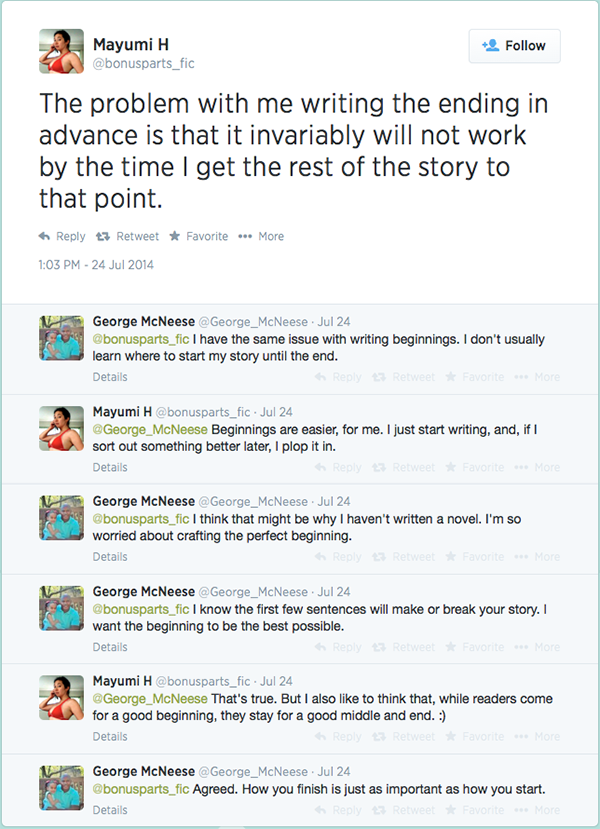by Mayumi-H | Oct 25, 2014 | Process
The title of today’s post comes from the age-old question: which came first? But, it’s not what came first that concerns me this time around, but what’s coming next. For me, it’s…NaNoWriMo 2014!
I know, I know: NaNoWriMo – or, National Novel Writing Month, that month-long free-write extravaganza, for those of you unfamiliar with that strange pseudo-acronym – isn’t really a test of my ability, as I’ve competed and “won” this not-competition five times, now. But, I just came off a few finished stories, and I want to give my brain a bit of a rest for a month. I still want to write, though, because I love the rush that comes with putting new ideas to paper. Since my proposed murder mystery/police procedural/love triangle story demands a more precise plot than my free-wheeling NaNo ways, I’ve decided to shelve ex-Detective-Sergeant Stenhall and the rest for a little while and instead write a yippee-kai-yay loosey-goosey continuation (of sorts) of my recently-completed Borderlands story. It focuses mostly on a group of original misfit characters that I’ve been itching to use for a long time, now, and even just my story prep has gotten me excited about writing this one.
So, for the next five weekly updates, I’ll likely be talking about word count and progress and stress-writing crap, as that’s usually what takes over my brain during NaNo. If you are participating this year, as well, why don’t you join me? Feel free to list your NaNoWriMo user ID in the comments section, here. I’m happy to have a friend in NaNo madness! My username is bonusparts.
For those of you not interested at all in my NaNo endeavors, I’ll leave you with this collage of photos from my recent trip to Japan, where I road lots of trains, ate lots of sushi, got sunburnt at my little nephews’ undoukai, visited the Suntory brewery factory, drank some great Japanese craft beer, and watched some little ninjas chase after a samurai at Toei Film Studios.
 What are your plans – writing or otherwise – for the rest of 2014?
What are your plans – writing or otherwise – for the rest of 2014?
by Mayumi-H | Oct 4, 2014 | Fearless, Finding Mister Wright, From Hell (A Love Story), Uncategorized
Today, I posted the final chapter of my sci-fi western romance, “From Hell: A Love Story.” It’s the third story I’ve finished this year, “Finding Mister Wright” and Fearless being the other two.
I always get a rush of mixed feelings whenever I write the last words to a story. Relief for having reached the finish line, but a sense of sadness, too, at saying goodbye to characters I’ve come to love over the drafting time. Some stories never move much past that first draft, for me, but others find their way to revisions, rewrites, and re-posts. Still others become launching pads for completely different stories…or, the same story woven in a new pattern, as is often the case for me.
My issue at this point is: What do I write next? I’ve got a continuing timeline set up for my sci-fi western characters, but I feel like giving them a rest for a bit. I’ve been doing some off and on revising of Fearless and “Finding Mister Wright” over the last few months, and I’m enjoying revisiting those worlds, but it’s not the same as new writing. It’s been years since I’ve gone without a new writing project, I’m not sure I could handle not having one! The good news, I suppose, is that I’ve got a few twelve-plus-hour plane rides to consider my options (or maybe start playing with that heretofore unknown something new). That’s right – I’m out of here for the next few weeks while I visit my family in Japan. So, I won’t be around to read/comment/blog much or at all. But, don’t worry – I will eat lots of yummy sushi and green tea soft-serve in your honor!
So. I’ve done romance. I’ve done family stories. I’ve done science fiction with a western twist. Maybe it’s time to poke at that detective murder mystery? What do you think? What helps you decide what project to tackle next? Do you rassle your Muse into cooperating, or do you let the faerie ramble?

Woo! Yeah! That’s right: Complete!
On a side note, as many of you know, I recently had a bit of a rough go. Many of you offered kind and supportive words for that, and I have to thank you. Your words really helped me move past what could have been a downturn. Some of you even said saying farewell to one friend would allow me to make room in my writerly life to make new friends…and I did! A mutual love of a shared universe put me in touch with a talented writer with whom I’ve enjoyed some of the best writing conversations about character, plot, and issues that I’ve had in a long time. And it’s felt glorious! The extra-awesome part? This writer is also a visual artist, who has offered to do art of my story, with my original character! I’ve been floating on clouds ever since I heard that. I will share if that’s allowed…but I may want to keep this one to myself.
by Mayumi-H | Jul 26, 2014 | Process
No deep thoughts this week. I’m working hard on the ending of my sci-fi western, so I’ll offer this recent conversation with Twitter buddy George McNeese:

(click to enlarge)
George is one of my favorite Twitter users because he always has thoughtful things to say, often about his own writing journey. That usually leads me to think more deeply about my journey, too, even when I’m in a tough place, as I am right now, re-crafting the ending of my current story. Especially when I’m in a tough place.
I write sequentially, which I enjoy doing because the story feels like it has more natural rises and dips that way. It also pre-empts issues like my current one, where the ending I wrote a year ago – the initial impetus for the story entire – doesn’t fit with the story that’s been built to come before it. It’s not the worst place to be, of course: the characters have grown a lot from that initial writing, too far into themselves to make that ending work. I think that’s a good thing. But it also means creating an almost entirely new ending moment that has the same emotional resonance as the one I first wrote 400 days or so ago.
A story needs to be strong on all counts: beginning, middle, and end. Finding that right (write?) balance for us is the tricky bit. What’s your favorite part of the story to write?
by Mayumi-H | Jun 8, 2014 | From Hell (A Love Story), Persona 4 Fan Fiction, Process
Last time, I talked about writing villains. Everybody had great comments, but Vanessa’s sparked a new idea in me. In my head (sometimes on paper), I have backstories for every character who walks onto my pages for any more than a sentence or two. Most of these backstories are rather simple, because I don’t see the point in spending too much time on a character who is basically just a spaceholder. But for anyone with any significance to the story, they have their own story. But Vanessa’s insight offered me a different perspective: basically, that we storytellers should remember that every good villain is the hero of his or her own story.
Now, this doesn’t necessarily mean that your villain needs to have heroic traits. But, their motivations and characterization should come from a place of realism. The best villains are often ones with whom a reader can personally identify. I don’t know if I managed that with the villains illustrated in last week’s post (actually, I doubt it), but it’s a good characterization technique to remember. So, this morning, I drafted up a couple of would-be storylines for each of those principal antagonists, posted below. If nothing else, it was fun to look at them from a new angle. I’d recommend doing something similar for your own antagonists – you never know when you might be struck with new inspiration.
The Red Widow
It’s a man’s galaxy. That’s what they say. Certainly, it seems that way to a girl sold into slavery for men’s pleasure. But this is no ordinary slave girl. This is one who learns from her so-called “masters”: how greedy, vain, and susceptible men are. Especially to a woman’s charms. Justiciar, pirate, or politician: no matter the insignia on their collar or the banner on their ship, men have their weaknesses, and she knows them all. Her marks have called her many names: Anya, Elsbeth, Illia, Una. But the galaxy knows her better as a woman as smart as any justiciar, as savvy as any pirate, as sly as any politician. It knows her as Red Widow. And she’s going to turn this man’s galaxy upside-down.
Into the Light (Lohengrin, the Swan Knight)
Abram had a son, once. A bright, beautiful boy full of possibilities. A gentle boy cherished for his kindness and skill with a tanner’s knife. The air would sing with the strokes of that knife, and wealthy women and men would come from across all districts to watch and buy his work. Abram loved his boy. But the Darkness loved him, too.
One day, that Darkness came for him, in the form of another smooth-faced boy, and lured Abram’s son away. Away, into the Darkness. What choice for a father but to save his only son? And the only way to save him from the dark was to lead him back into the light. With fire.
The Darkness has taken other boys. The Lost Boys, they are. But he will save them. He will take up arms and become their knight, to set them free, body and soul. He will be Lohengrin, the Swan Knight, their savior.
The Body Electric (Reilly)
The Dahl Army gave Reilly everything: a job, a purpose, even something like a family. For twelve fine years, he fought, laughed, caroused, and conquered by the sides of his fellow commandoes and their skilful sergeant. But on what is supposed to be a routine grab-and-go mission on Artemisia, the unthinkable happens: the op goes sour. An explosion and fire burns away half his soldierly body. And what does Dahl do? They dump him like scrap.
When the Hyperion salvage team finds him rotting in an Artemisian infirmary, they see his potential, and make him an offer: Become part of the Body Electric, a soldier enhanced for the technological wars. Of course, a soldier with potential needs a purpose, but Reilly has a purpose: hunt down his old teammates who left him to die, starting with his glory-hungry sergeant, the man responsible for it all.
Every Shot a Kill (Strenk)
Walking around the galaxy with the S&S munitions manufacturer family name stenciled on his uniform has never meant much to Lukas Strenk. Guns are just tools, only as good as the man who holds ‘em. And he is a great man, the best in the Inner Ring. Every shot from Strenk’s Orion rifle is a kill. But even the simplest kills can go wrong. When Galactic Defense redacts his latest target assignment after knowing the job’s already been done, they blame Strenk, of course, never mind his 100% success rate and the value of his name. “Get yourself gone or get yourself dead,” the GD Justiciar tells him. Strenk’s only answer is a bullet.
To hell with the shifting, shifty so-called rules of the Inner Ring. When the galaxy gives you lemons, you shove ‘em straight up its gaping *** and lick the residue from your fingers.
Once again, I think Strenk came out on top as my favorite of these, though I enjoyed the exercise for all. Have you ever flipped the coin on your antagonists? Have you ever found you identify more with a villain than a hero in a story? Let me know!
by Mayumi-H | May 31, 2014 | Persona 4 Fan Fiction, Process
Recently, I had an interesting dialogue with a writer friend on Twitter. He’d looked through my sci-fi/western/drama/romance and mentioned how “graphic” it is. I agreed that it’s probably “the most gleefully graphic I’ve let myself get in a long time.” Our conversation became more about writing side stories, but I kept thinking about why I’ve enjoyed working with this particular story so much these past few months. Part of that reason is that personal allowance to be graphic, an allowance I haven’t given for my more recent original fiction. There’s a lot of sex, because that’s a big part of the main character’s personal journey, but I’ve also loaded it with more action and violence than I’ve done in a while. Following that thought, I came to realize that it’s the villains who have made this story so much rollicking fun, for me.
I’ve read analyses that say the villain is the most important part of the story. I don’t exactly agree with that wording, because not every story will have a “villain.” In more precise – and also more amorphous – terms, I think it’s conflict that drives a story. I’ve talked about this a bit before, but I want to go into some more detail, here.
Every story needs some conflict, whether it’s external or internal. It’s nice to see characters get a breather or spend some happy time together, but a whole book about that would be rather boring. My drama stories tend to lack a villain in the traditional sense because the conflict usually arises from the hero himself. One of the common characterizations in my stories is that each main character is the principal architect of his or her own happiness…or their own misery. The decisions they make determine how they move forward or backward. Of course, I like development, so they usually set themselves – or get themselves set – on the right path, but the journey’s the fun part, anyway. That said, I hadn’t written a real villain in a long time.
Then, I decided to write a western.
I spent a lot of days reading old westerns, especially the serial stories of Elmore Leonard. The villains in those short stories were varied, violent, cunning bastards. And, even if they only made themselves known for a few pages, they had presence. I wanted my sci-fi shoot-em-up western to have that. Because, while the main character’s internal conflict was perhaps the most important part of the story, he would never be able to make that journey of self-discovery without someone pushing him on. Or shooting at him, as the case came to be.
I love writing my heroes. But, I’ve loved writing these villains, too, each one of them, for their own reasons. Red Widow because she’s a smart, sexy grifter, and deadly for that:
She’d saved her head with her hands, and pushed back against the wall to shove him off. One leg flew out behind her, connecting with Hal’s gut. He staggered with an oof! and she spun, another kick catching him in the ear.
Lohengrin, the Swan Knight, is insane. But his insanity is full of such self-righteous zealotry, his every line full of such grandeur, he makes a formidable foe:
Lohengrin swung his flame toward the popping drehlafette, and licking fire met stoic metal as the autocannon’s barrel slid into place. The muzzle spit its first round, and its second, when the Swan Knight gave a sudden strangled gasp.
Reilly is driven by a simple desire for revenge, but it’s changed him to the point of being unrecognizable even to his old sergeant:
Ax froze at the sight: a gleaming, golden horror of a man, almost seven feet tall with pylons for limbs and black enhancement goggles pressed deep into the puckered flesh of his face. In front of his left eye glowed a red targeting reticle, blazing in the dark. His chest was pockmarked with sparking holes and indentations from the drehlafette, but none of them slowed him down.
And Strenk, who’s probably my favorite of the lot, simply because he has no overarching goal or reason for his grittiness. He’s just plain ol’ nasty:
Strenk’s gaze filled his focus, cold and damning. “Open those pretty petals, tulip.” He dropped his free hand to his crotch. “I want to see if I’ll fit.”
All of these villains do horrible things, and I occasionally feel a bit scared at how easily some of their actions and dialogue have come to me. At the same time, though, I believe in art as a catharsis and unhindered outlay of our personalities, both the dark and light parts of it. Art is also a relatively safe way to explore the more dangerous demons within each of us. I don’t think I could ever pick up a flamethrower and point it at someone, but it definitely gets my senses tingling to imagine that and create it on the page. I suppose what this exercise has truly shown me is that my villains have as much to say about me as they do about my hero. Their danger, their brutality, the sheer ugliness they represent have made this story a crazy-fun ride, because for every dark, twisted action they throw at him, my hero grows a little bit stronger, a little bit wiser, a little more…heroic. But then, isn’t that what a villain is supposed to do?

What is it about your villains that you love? (Come on, admit it: there’s a part of you that loves ’em!)
 What are your plans – writing or otherwise – for the rest of 2014?
What are your plans – writing or otherwise – for the rest of 2014?



Recent Comments